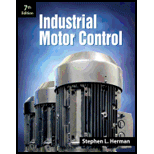
EBK 3N3-EBK: INDUSTRIAL MOTOR CONTROL
7th Edition
ISBN: 9780176919962
Author: Herman
Publisher: VST
expand_more
expand_more
format_list_bulleted
Question
Chapter 54, Problem 5RQ
To determine
The number that is set on a timer to be programmed for the delay of 3 minutes.
Expert Solution & Answer
Want to see the full answer?
Check out a sample textbook solution
Students have asked these similar questions
Consider the bar, shown in Figure 1 that undergoes axial displacement due to both a distributed load
and a point force. The bar is of cross-sectional area A = 1.10-3 m², and has a modulus of elasticity
E = 100 GPa.
1(x) = 5 kN/m
x=0.0
x=2.0
2.0m
10 kN
Figure 1: Bar domain with varying distributed forces.
a) The general form of the governing equations describing the bar's displacement, u(x), is given by,
d
(AE du(x))
-) +1(x) = 0.
d.x
dx
What are the accompanying boundary conditions for this bar?
b) Using the mesh in Figure 2, form the basis functions associated with element 2 and write the FEM
approximation over the element.
1
2
3
1
2
1m
1m
Figure 2: Mesh of 2 elements. Elements are numbered with underlines.
c) The general form of the element stiffness matrix system, with nodes indexed by i and j, is,
AE
Uj
N;(x)l(x)dx
– Ng(0)f(0)
¥ [4]}]{{}}={{{}\(\\+} + {N(2)f(2) = N (0)5() },
(1)
0, respectively.
L
=
(2)
where f(2) and f(0) denote the boundary forces at positions x 2 and x
Evaluate…
answer please
amination)
Question 1
Consider the bar, shown in Figure 1, that undergoes axial displacement due to both a distributed load
and a point force. The bar is of cross-sectional area A = 1.103 m2, and has a modulus of elasticity
E = 100 GPa.
1(x) = 5 kN/m
10 kN
X
x=0.0
x=2.0
2.0m
Figure 1: Bar domain with varying distributed forces.
a) The general form of the governing equations describing the bar's displacement, u(x), is given by,
d
(AE du(x)) + 1(x) = 0.
dx
dx
What are the accompanying boundary conditions for this bar?
MacBook Air
a
会
DII
F5
F6
F7
F8
80
F3
F4
0/
20
[8 marksl
8
FO
Chapter 54 Solutions
EBK 3N3-EBK: INDUSTRIAL MOTOR CONTROL
Ch. 54 - Why are NEMA symbols representing such components...Ch. 54 - Explain how to program an internal relay into the...Ch. 54 - Why are the contacts used to represent stop...Ch. 54 - Why is the output I/O used to energize a motor...Ch. 54 - Prob. 5RQCh. 54 - When programming in Boolean, what command is used...Ch. 54 - When programming in Boolean, what command is used...Ch. 54 - When programming in Boolean, what command is used...Ch. 54 - Why are the numbers 8 and 9 not used in an OCTAL-...
Knowledge Booster
Similar questions
- show workingarrow_forwardCFD help Figure 3: Advection equation, solution for three different timesteps. Q1) Provide an explanation what conditions and numerical setup could explain the curves. Identify which of the three curves is the first, second and third timestep.arrow_forwardanswer pleasearrow_forward
- Figure 3 shows the numerical solution of the advection equation for a scalar u along x at three consecutive timesteps. 1.0 0.8- 0.6 0.4- 0.2 0.0 00 -0.2 -0.4 -0.6- 3.0 3.5 4.0 4.5 5.0 5.5 6.0 6.5 Figure 3: Advection equation, solution for three different timesteps.arrow_forwardQuestion 2 Figure 3 shows the numerical solution of the advection equation for a scalar u along x at three consecutive timesteps. 1.0 0.8- 0.6- 0.4- 0.2- 0.0- -0.2- -0.4- -0.6 3.0 3.5 4.0 4.5 5.0 5.5 6.0 6.5 Figure 3: Advection equation, solution for three different timesteps. a) Provide an explanation what conditions and numerical setup could explain the curves. Identify which of the three curves is the first, second and third timestep. b) Consider explicit schemes with central and upwind discretisations. Explain how each of these candidate discretisations could produce the behaviour shown in Figure 3. c) Determine the CFL number that was used in the simulation for each of the candidate schemes for all possible updates. Assume that the timestep and mesh-width used are constant. Read the data to two digits of accuracy from Figure 4 shown at the end of the question, which is an enlarged version of Figure 3. Demonstrate your method and input data for one calculation, but then use a…arrow_forwardanswer pleasearrow_forward
- Provide an explanation what conditions and numerical setup could explain the curves. Identify which of the three curves is the first. second and third timestep.arrow_forwardWhat are the accompanving boundary conditions for this bar?arrow_forward1.1 Consider the fireclay brick wall of Example 1.1 that is operating under different thermal conditions. The tem- perature distribution, at an instant in time, is T(x) = a+ bx where a 1400 K and b = -1000 K/m. Determine the heat fluxes, q", and heat rates, q, at x = 0 and x = L. Do steady-state conditions exist?arrow_forward
arrow_back_ios
SEE MORE QUESTIONS
arrow_forward_ios
Recommended textbooks for you
 Understanding Motor ControlsMechanical EngineeringISBN:9781337798686Author:Stephen L. HermanPublisher:Delmar Cengage Learning
Understanding Motor ControlsMechanical EngineeringISBN:9781337798686Author:Stephen L. HermanPublisher:Delmar Cengage Learning Precision Machining Technology (MindTap Course Li...Mechanical EngineeringISBN:9781285444543Author:Peter J. Hoffman, Eric S. Hopewell, Brian JanesPublisher:Cengage Learning
Precision Machining Technology (MindTap Course Li...Mechanical EngineeringISBN:9781285444543Author:Peter J. Hoffman, Eric S. Hopewell, Brian JanesPublisher:Cengage Learning

Understanding Motor Controls
Mechanical Engineering
ISBN:9781337798686
Author:Stephen L. Herman
Publisher:Delmar Cengage Learning

Precision Machining Technology (MindTap Course Li...
Mechanical Engineering
ISBN:9781285444543
Author:Peter J. Hoffman, Eric S. Hopewell, Brian Janes
Publisher:Cengage Learning